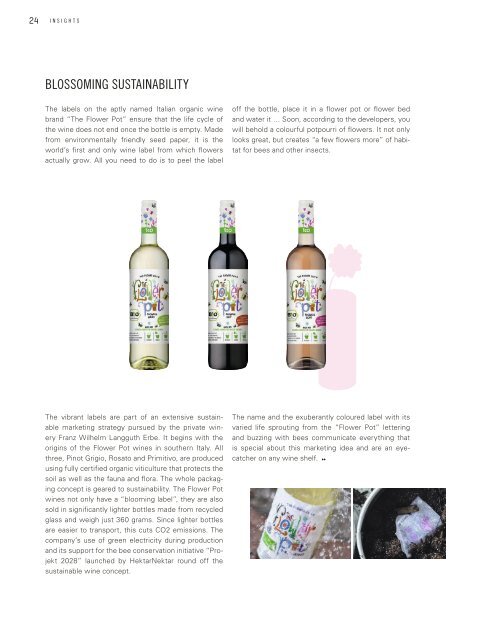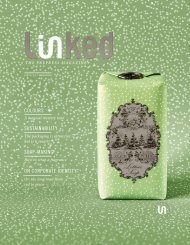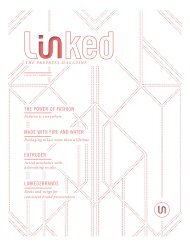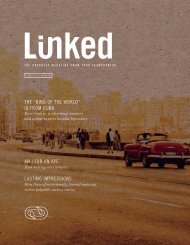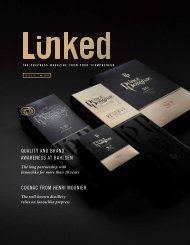Janoschka magazine Linked_V8_2023
The customer magazine by Janoschka and Linked2Brands.
The customer magazine by Janoschka and Linked2Brands.
Create successful ePaper yourself
Turn your PDF publications into a flip-book with our unique Google optimized e-Paper software.
24 i n s i g h t s<br />
issue #8 ©<br />
l i n k e d<br />
25<br />
BLOSSOMING SUSTAINABILITY<br />
The labels on the aptly named Italian organic wine<br />
brand “The Flower Pot” ensure that the life cycle of<br />
the wine does not end once the bottle is empty. Made<br />
from environmentally friendly seed paper, it is the<br />
world’s first and only wine label from which flowers<br />
actually grow. All you need to do is to peel the label<br />
off the bottle, place it in a flower pot or flower bed<br />
and water it … Soon, according to the developers, you<br />
will behold a colourful potpourri of flowers. It not only<br />
looks great, but creates “a few flowers more” of habitat<br />
for bees and other insects.<br />
EACH WINE MUST BE SERVED<br />
AT THE RIGHT TEMPERATURE<br />
Labels concealing a very different kind of “add-on”<br />
are affixed to a white wine from the Lake Constance<br />
region in Germany. Dew forms pearls on the champagne-coloured<br />
bottle. The label is minimalist, exhibiting<br />
a simple elegance with plain lettering set against<br />
green water colours. But when chilled, the shape of<br />
Lake Constance gradually appears in a watery blue<br />
hue as if the fog were lifting. Once the whole lake<br />
has emerged, you know the wine has reached its<br />
correct drinking temperature: 8 degrees Celsius. This<br />
cuvée comes with a thermal label that changes with<br />
the temperature to create this special effect.<br />
The vibrant labels are part of an extensive sustainable<br />
marketing strategy pursued by the private winery<br />
Franz Wilhelm Langguth Erbe. It begins with the<br />
origins of the Flower Pot wines in southern Italy. All<br />
three, Pinot Grigio, Rosato and Primitivo, are produced<br />
using fully certified organic viticulture that protects the<br />
soil as well as the fauna and flora. The whole packaging<br />
concept is geared to sustainability. The Flower Pot<br />
wines not only have a “blooming label”, they are also<br />
sold in significantly lighter bottles made from recycled<br />
glass and weigh just 360 grams. Since lighter bottles<br />
are easier to transport, this cuts CO2 emissions. The<br />
company’s use of green electricity during production<br />
and its support for the bee conservation initiative “Projekt<br />
2028” launched by HektarNektar round off the<br />
sustainable wine concept.<br />
The name and the exuberantly coloured label with its<br />
varied life sprouting from the “Flower Pot” lettering<br />
and buzzing with bees communicate everything that<br />
is special about this marketing idea and are an eyecatcher<br />
on any wine shelf.<br />
The online wine dealer Hawesko uses the same principle.<br />
For its young and exclusive own brand “Fleur de Fruit”, the<br />
company has transferred the successful concept of special<br />
editions to wine. Differentiation is the name of the game,<br />
after all, and that works best as part of an overall marketing<br />
strategy using innovative packaging solutions. In the case<br />
of “Fleur de Fruit” wines, one rosé and one white, labels<br />
that react to temperature reflect the sophistication of the<br />
two Atlantic wines: their freshness and light aromas fully<br />
unfold once the wine reaches the perfect, cool drinking<br />
temperature. And when is it that? Once the flowers on the<br />
label bloom in full colour.<br />
Wine label design can combine innovation, art and marketing<br />
to superb effect. If the producer is open to new and<br />
original ideas, labels can become marketing strategy instruments:<br />
they tell stories, communicate the taste and personality<br />
of the wine with the power of suggestion, and form<br />
an inner connection between the wine and the consumer<br />
that goes far beyond their visual elements. In that way, they<br />
stand out from the sea of wines and awaken desires.


